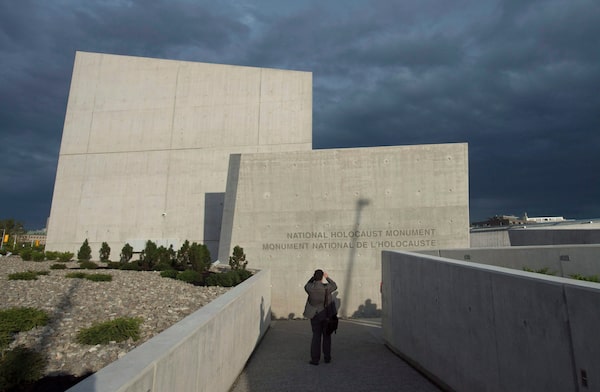
Parliament unanimously passed the National Holocaust Monument Act in 2011, which was initiated by the minister of foreign affairs at the time, John Baird. The monument was unveiled by Prime Minister Justin Trudeau in 2017.Adrian Wyld/The Canadian Press
Mark Kristmanson is former chief executive officer of the National Capital Commission.
Last month, a disturbing misuse of Ottawa’s National Holocaust Monument came to light. A photographer posted images on Instagram of a sexy fashion shoot taken at the site, attesting not just to the monument’s arresting visual presence but also its relative obscurity as a hallowed place. Deeming the photographs “totally inappropriate,” MP Greg Fergus said he was ”stunned by the lack of common sense ... of all those involved.”
It’s not the first thoughtless use of this seminal commemoration as a backdrop: Selfie-taking visitors have also become targets of online criticism in recent years.
If people knew more about the monument’s genesis, might they understand its gravitas?
In the late 2000s, university student Laura Grosman pointed out that Ottawa was the single wartime Allied capital lacking a Holocaust commemoration. An earlier attempt to house a memorial within the war museum had foundered in the 1990s. The tide turned in 2011 when Parliament unanimously passed the National Holocaust Monument Act. Initiated by the minister of foreign affairs at the time, John Baird, the monument was unveiled by Prime Minister Justin Trudeau in 2017.
This six-year turnaround from inception to completion was exceptional for a major national commemoration. Fully 20 years passed after the 1919 Treaty of Versailles before Canada’s National War Memorial was unveiled by King George VI. Looking to London, last month the High Court quashed the planning approval for the U.K.’s new Holocaust memorial, thereby creating serious delays for the £100-million ($160-million) monument and underground visitor centre slated to have opened last year in a Westminster park adjacent to Parliament.
Remarkably, an earlier iteration of the London memorial’s design was submitted by Ghanaian-British architect David Adjaye and Israeli designer Ron Arad to the National Capital Commission’s juried competition in 2015. Mr. Arad mesmerized the packed room with his gnostic explication of the enigmatic finned sculpture. Ultimately, though, it was architect Daniel Libeskind’s disarticulated Star of David, a scheme intuitively advantaging the commission’s elongated triangular site on LeBreton Flats, that won the day.
By holding an international competition, the NCC attracted a stellar roster of designers. It was museum consultant Gail Lord who aligned Mr. Libeskind with Toronto photographer Edward Burtynsky, University of Toronto historian Doris Bergen and Montreal landscape architect Claude Cormier to form the winning consortium. The NCC generated advice to the government regarding site selection, public consultations, jury composition and expert advisers, and contracted the construction.
Setting a sage budget target of $8.5-million, including $4.5-million to be raised through donations, greatly increased the likelihood of success. Securing private funding for state-led commemorations can never be taken for granted. A council of prominent Canadians was appointed to raise the funds and provide advice, and they succeeded in both.
While the constructors achieved unprecedented architectural expressions in formed concrete, Mr. Burtynsky embarked on a photographic pilgrimage across eastern Europe. Subtly, he infused forebodingly pastoral images of Holocaust sites on Mr. Libeskind’s giant angled slabs. Rare tenacious shrubs specified by Mr. Cormier were sourced and nurtured for the rocky garden setting. Prof. Bergen led the highly charged task of developing the interpretation display.
There is a book to be written on navigating long-cycle initiatives through midstream changes in government. It is a credit to the federal parties that this project was carried forward to a distinguished conclusion, though it would be misleading to say there were no tensions. These distracted from what was a moment of profound national reflection. Still, even though widespread public recognition was deferred, the monument garnered critical praise and architectural awards.
Under its rubric “landscape of loss, memory and survival,” it redressed a long-standing lacuna in our commemorative landscape. Occupying its ground with jagged force and stark beauty, adept in its making, the National Holocaust Monument acknowledges Canada’s “None is too many” immigration policy that resulted in countless Jewish deaths. Moreover, at the insistence of Vera Schiff and other survivors, it testifies to universal themes of resistance and resilience.
No doubt those survivors would encourage visitors to photograph it often, indeed endlessly, but for the right reasons.
Keep your Opinions sharp and informed. Get the Opinion newsletter. Sign up today.